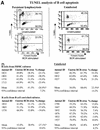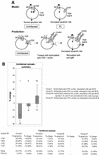CD5 is dissociated from the B-cell receptor in B cells from bovine leukemia virus-infected, persistently lymphocytotic cattle: consequences to B-cell receptor-mediated apoptosis
- PMID: 11160667
- PMCID: PMC114078
- DOI: 10.1128/JVI.75.4.1689-1696.2001
CD5 is dissociated from the B-cell receptor in B cells from bovine leukemia virus-infected, persistently lymphocytotic cattle: consequences to B-cell receptor-mediated apoptosis
Abstract
Bovine leukemia virus (BLV), a retrovirus related to human T-cell leukemia virus types 1 and 2, can induce persistent nonneoplastic expansion of the CD5(+) B-cell population, termed persistent lymphocytosis (PL). As in human CD5(+) B cells, we report here that CD5 was physically associated with the B-cell receptor (BCR) in normal bovine CD5(+) B cells. In contrast, in CD5(+) B cells from BLV-infected PL cattle, CD5 was dissociated from the BCR. In B cells from PL cattle, apoptosis decreased when cells were stimulated with antibody to surface immunoglobulin M (sIgM), while in B cells from uninfected cattle, apoptosis increased after sIgM stimulation. The functional significance of the CD5-BCR association was suggested by experimental dissociation of the CD5-BCR interaction by cross-linking of CD5. This caused CD5(+) B cells from uninfected animals to decrease apoptosis when stimulated with anti-sIgM. In contrast, in CD5(+) B cells from PL animals, in which CD5 was already dissociated from the BCR, there was no statistically significant change in apoptosis when CD5 was cross-linked and the cells were stimulated with anti-sIgM. Disruption of CD5-BCR interactions and subsequent decreased apoptosis and increased survival in antigenically stimulated B cells may be a mechanism of BLV-induced PL.
Figures





References
-
- Berman J J, Moore G W. The role of cell death in the growth of preneoplastic lesions: a Monte Carlo simulation model. Cell Prolif. 1992;25:549–557. - PubMed
-
- Bikah G, Carey J, Ciallella J R, Tarakhovsky A, Bondada S. CD5-mediated negative regulation of antigen receptor-induced growth signals in B-1 B cells. Science. 1996;274:1906–1909. - PubMed
-
- Brooks P A, Cockerell G L, Nyborg J K. Activation of BLV transcription by NF-κB and Tax. Virology. 1998;243:94–98. - PubMed
Publication types
MeSH terms
Substances
Grants and funding
LinkOut - more resources
Full Text Sources
Research Materials

